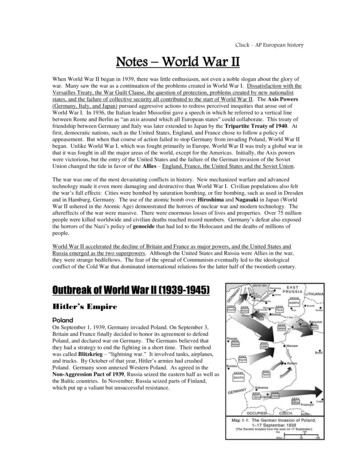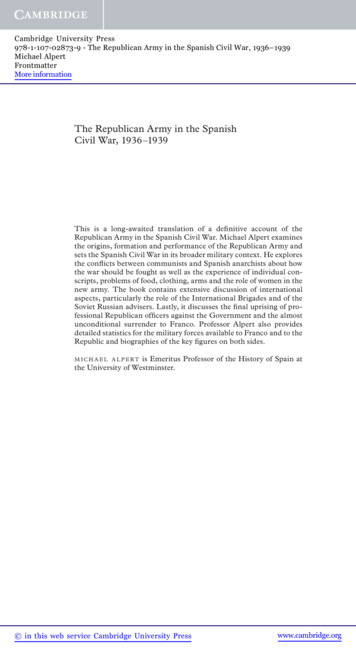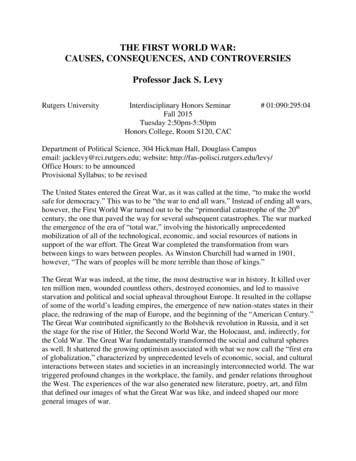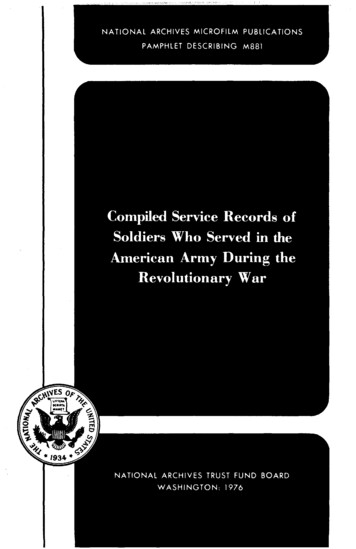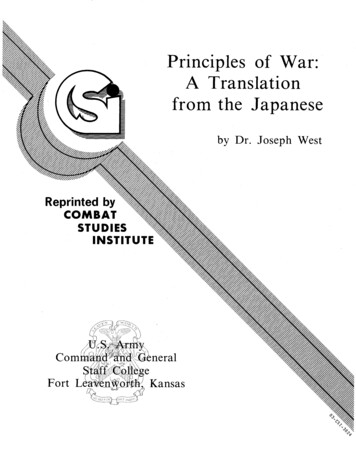
Transcription
Principles of War:A Translationfrom the Japaneseby Dr. Joseph WestReprinted byCOMBATSTUDIESINSTITUTEU.S.Army \: "'''' :" ' . v *;Command and GeneralFort Leavenwofth, Kansas
FOREWORD———Principles of War is a reprinted translation from the Japanese. The idea for the translationcame from Colonel Tsutomu Matsumura, Japanese Liaison Officer at the Command and GeneralStaff College at Fort Leavenworth, Kansas. Knowing the nature of the original version and beingkeenly aware of the role played by historical examples, Colonel Matsumura suggested Principles ofWar be shared with a larger, English speaking audience. Upon approval by the Deputy Commandant,USACGSC, Dr. Joseph West translated the book under TRADOC contract.Senri nyumon (An Introduction to the Principles of War) is required reading for all JapanGround Self-Defense Force officers. The book is not read once and forgotten — it is one of thebasic texts studied by Japanese officers in preparation for the highly competitive entrance exam tothe Japanese Command and Staff School. Unlike many books about tactics, Principles offers alively and vivid picture of the art of warfare. The chief reason for this quality lies in the use ofspecific historical examples of battles won and lost to illustrate a particular tactic or principle. Ina narrow sense, it reveals the value of military history when properly applied to abstract concepts.The historical examples are wide ranging and diverse. The authors have great respect for theevolution of military science, drawing on Eastern and Western military experiences alike. By offeringsamples rich in military tradition, the book affords new insights for the American officer which willbroaden and deepen his historical consciousness.ManyIn orderselectivereader toof the battles cited in Principles will not be immediately recognizable to American readers.to enhance the usability of the material, the Combat Studies Institute has appended abibliography of material relating to the examples used in the text. This will enable thepursue additional study in selected areas of interest.CSI REPRINTS contain unique, out of print, or difficult to obtain material on military history topics.The views expressed in a CSI REPRINT are those of the author(s) and not necessarily those of theDepartment of the Army or the Department of Defense.
PrefaceHitherto, a relatively large amount of partial and fragmentary literatureconcerning the principles of war has been found here and there, "but asystematized work has not existed up to now.There are difficulties in systematization of the principles of war that shedlight on its true nature (theory that has the character of developing dialectically from rationality and actual proof). But in view of the state of knowledgeof modern young officers, etc., as stated in the Forward, since it is fullyrealized that study of the principles of war is an urgent necessity, systematization was undertaken through the Board for Study of the Principles of War.In this systematization, under the direction of Instructors Onizawa, Nozoe, andYamanouchi, and with Instructors Daihachi Matsumoto, Kiyofuji, and Maeda as anucleus, a draft was compiled in March 19&7 a*1 J great effort, was generallycompleted in August, and its essentials were presented incrementally through theKanbu-gakko-kiji LStaff College Newsl.Fortunately, it received a favorable reception from all of you readers, and now,in response to your request that it be brought out in book form, it has beenedited by Instructor Tomizawa and has reached the stage of publication as areference work for beginning students of military tactics. Of course, this bookis only one step in the study, and there is believed to be much room for improvement, but the book is being presented hurriedly for use by beginningstudents in diligently teaching themselves, and it is hoped that you readerswill give us your suggestions and corrections.Finally, profound gratitude is expressed to Nishiura, Chief of the MilitaryHistory Department of the National Defense College, who provided guidance concerning the approach to the principles of war; to Tanaka Shoten CTanaka BookCompany], that devoted exceptional effort to the publication; and to ColonelToshinobu Ikeda and to the Board members listed below.January 1969Kaoru Aoki, Maj Gen, Board ChairmanSekiteru Yamada, Maj Gen, Board Vice ChairmanBoard for Study of the Principles of WarGround Self-Defense Force Staff College— 1—83-CSI-3824
Urban areaSwampy ( iland [ I j l jLakes andmarshesWoodlandterrainMountainousareaMembers of the Board for Study of the Principles of WarKentar5 AnabukiMinoru UekiKaoru OnisawaYuko KashiwabaMakoto KatoToshio KamoKokki KiyofujiYasushi KunigoOsamu KonoKeijiro SakaeHarutaka SasakiHisashi ShibataNobuyuki SuzukiSeiichi TauchiKenji TakagiInao TanakaSunao ChamuraMatsuji TomisawaMitsukuni NarishigeShoki NoguchiNaoyuki NozoeTakatomo HamaguchiHitoshi FujiyoshiKiyomi HaruyamaRyoichi FunakoshiHachiro MaedaShosuke MakiMasaya MakiKatsunori MakinoTomohiro Matsui'Daihachi MatsumotoYonejiro MatsumotoTomoyoshi MikiTakeji YamauchiTaneaki YamanouchiKazuo YamamuraIt is very gratifying here to be able to submit to the officers of the GroundSelf-Defense Force the Introduction to the Principles of War, which has broughttogether the study results of our school's Board for Study of the Principles ofWar,It goes without saying that explaining the "principles of combat" andother principles (except doctrine matters) presented in textbooks, asthe various fundamentals which are omitted from the textbooks but arefor the various principles, is the point of departure for improvementtegic capability.the manywell asthe basisin stra-However, in order to be able, under all situations, to make accurate decisionsand to form creative plans that accomplish the mission, it is absolutely necessary ordinarily to identify these principles in all military histories and otherbooks on military science, to give careful thought and consideration to them, totrain in them through applied tactics and field exercises, and to incorporatethem into one's own capability.- 2-
This book sought and analyzed proven lessons in military history concerning theprinciples of war considered particularly important up to about the end of WorldWar II, compared and carefully examined well-known ancient and modern books onmilitary science, and consolidated and systematized the material, and it is believed to be a good reference book for young officers seeking to study strategyand tactics. Of course, in the implementation of applied tactics, field exercises, etc., it should be borne in mind that the principles of war presented inthis book should not be followed blindly in making one's decisions, but, asstated above, one must confront matters with something that, through diligentstudy, has become an integral part of one's own capability.In regard to principles of war that must be added anew after World War II (suchas, for example, the principle of war of countering indirect aggression), theremust be continuing study and a quest for critiques everywhere, in order toensure greater perfection.January 1969Haruo Umezawa, Lt GenCommandant, Ground Self-Defense Force Staff CollegeTable of Contents CPageHrT5Preface1Forward2Part I. INTRODUCTION6Chapter I.Initial Remarks6Chapter II. The Essence of Warfare and the Characteristicsof Land WarfareChapter III.Meaning and Nature of the Principles of WarPart II. MEANING AND CHARACTERISTICS OF COMBAT POWER61011Chapter I. Meaning and Basic Principles of Combat Power11Chapter II, Organizing and Coordinating Combat Power16Chapter III.19Tactical Opportunity and the Surprise AttackChapter IV. Frontal Combat Power and Combat Power in Depth23Chapter V.25Containment and Strike- 3-
CPageDPart III.CONCEITRATION OF COMBAT POWERChapter I.Chapter II.27SummaryCentripetal Use of Combat Power27.31Section 1.Principle of centripetalism31Section 2.Operations on exterior lines32Section 3.Advancing from different directions and linking upto attack36Section k.Envelopment39Section 5.BreakthroughU2Chapter III.Eccentric Use of Combat PowerU7Section 1.Principle of eccentricity 7Section 2.Operations on interior linesU8Section 3.Defeating piecemeal52Chapter IV.Part IV.Antiamphibious and Anti-Air-Landing OperationsTURNING AN ENEMY'S COMBAT POWER AGAINST HIMSELFChapter I,Chapter II.Reverse Use and Manipulation of MomentumDiversion and Countered DiversionSection 1.6062626UMeaning and characteristics of diversion andcountered diversion6URelationship between the main operation andsecondary operation69Section 3.Delaying operation70Section U.Unit acting on the flank of the main force73The Battle of Extermination on the Battlefield76Section 2.Chapter III.
CPagelPart V. HOLDING THE INITIATIVEChapter I.78Summary78Chapter II. The Meeting Engagement78Chapter III.80Chapter IV.Part VI.Decisive Battle Outside the Prepared PositionInterdiction of the RearLIMIT OF COMBAT POWER8388Chapter I. Calculation of the Turning Point in a Battle88Section 1. Summary88Section 2. Counteroffensive88Section 3. Offensive's termination point9 Section k. Vying in extending a flank and in enveloping96Chapter II. Pursuit and Retrograde MovementSection 1. Pursuit97Section 2. Retrograde movementPart VII.97OPERATIONS IN SPECIAL TERRAIN, ETC.101106Chapter I, Summary106Chapter II. Operations (Combat) Based upon the Special Natureof the Terrain106Chapter III,115Combat Using Nighttime Darkness, etc.Postscript117- 5-
Part I.INTRODUCTIONChapter I, Initial RemarksIn connection with the planning of the Yalu River river—crossing attack at thebeginning of the Russo-Japanese War, General Tamemoto Kuroki, Commander of theCJapaneseH First Army, in one paragraph of his instructions to his assembledstaff, stated that, "In the military operations of the First Army, particularlythe operations at the beginning of the war, if we do not act so that future historians cannot raise even one point of criticism, we should fail in our samuraiduty, . Since the plan was made with such care and logic, even if the worstshould happen, that would not be a matter for regret; it would be divine will. and I ask that you perform so that future readers of history will Judge thatit was with complete dedication,"And FranceTs famous military commander, Marshal Foch, said, "The art of war,like other arts, has its fundamental principles. If that were not the case, warwould not be an art. War is learnable and is something that must be learned; itis an understanding of the true nature of war gained through extensive and intensive study o-f military history that is the basis for study of the art ofwar," Again, in regard to the principles of wajr, he also said, "There is a gapbetween knowing and having ability, but with absolutely no knowledge, it is notpossible to move in a single jump to having ability. In contrast, if one hasthe knowledge, one can have the ability. Knowledge is a necessary condition.If one has knowledge, in a short time one would gain confidence, and confidencebrings accurate decisions," These are wise statements presenting suggestionsfor both the East and the West concerning the principles of war and the development of capability with them; and, in general, for persons studying the artof war, they clarify the principles and rules of warfare (the so-called principles of war) and show the importance of knowing them and developing theability to apply them.Particularly for beginning students, it is believed that the essence of improving tactical capability is, first, studying these "principles of warfare"fundamentally and scientifically, then deepening one's understanding of the"knowledge," making this "knowledge" one's guide, accumulating "substantiatingevidence" from "military history," developing this base for judgment (capability), and training and improving judgment (capability) through applied tactics(map and terrain exercises, war games, and field exercises).This book has the objective, from the above viewpoint, of providing beginningstudents of tactics with deeper understanding of the principles of land warfareand with a basis for future improvement in tactical capability.Chapter II. The Essence of Warfare and theCharacteristics of Land Warfare1. The essence of warfarea. What is warfare?War is a clash of opposing wills, a struggle between beliefs, and victory goes- 6-
to the party that crushes the enemy's will and destroys his "beliefs.In other words, the warfare discussed here is a struggle for victory, using"power" to cause the opponent's will to yield and our will to prevail.Hence, "the essence of warfare" is "power" and its maximum use. Its objectiveis to crush the opponent's power of resistance and cause him to submit to ourwill, and its measures are to use power to destroy the opponent's fighting power(material, spiritual). In other words, it is nothing less than the seizure ofvictory.b. The essence of warfare and its characteristicsThe first essential element of warfare is the fact that, "in warfare, there areopponents." Moreover, both parties are characterized by having free will.The second is that both parties have the will to overthrow the opponent (enemy).War is a struggle between the free wills of both parties, and victory is determined by which one has confidence in it. In other words, it also can be saidto be a struggle of faith.The third is that power is used to cause submission of the opponent's will. Thedirect instrument for fighting is "power," and when this power is brought tobear against the opponent, it is used for the violent effect of causing submission of the opponent's will.The fourth is the actual battlefield situation, which is extremely important forour study of tactics and is a basic condition. The actual battlefield situationarises from the above essential elements of warfare and varies according to thetime period, the place of combat, and the type and scale of warfare, etc.The most important of these are that, in warfare, the situation always is uncertain, unstable, and unclear, and the normal state is that there is a succession of inconsistencies and mistakes, danger to life is ever-present, mental andbodily difficulties of fear, exhaustion, etc., are encountered, the situationdoes not develop as expected, etc.In the study of the principles of war and in the study of tactics, if thoroughconsideration is not airways given to the actual battlefield, one will end up inworthless speculation.2. Characteristics of land warfarea. In warfare, the essential role of land warfare (land operations) is thecontrol of persons, and its instrument is the control of land.Hence, the sphere of activity of land units is the land, and the characteristicsof the land are the dominant factors governing the character of land warfare.Progress in science and technology contributes greatly to liberation from various limitations of the land, but has not reached the point of changing the basicnature of land warfare.
Also, in the operational environment of land warfare, there are various conditions that affect the handling of troop units and the will of the commander.The principal factors comprising these are national policy (politics, foreignrelations, the economy, military affairs, social psychology, etc.), the zone ofoperations, opposing (enemy) forces, "weapon systems, etc., "but in this book aretreated primarily only matters related to the principles of land-warfare tactics."b.Natural characteristics of the land and their effectThe major elements in the natural characteristics of the land are terrain andweather. It is clear that terrain and weather are closely related to land warfare and that they control the nature of land warfare, "but here the discussionis on the general characteristics; special characteristics of terrain and theireffect are discussed in Part VII, Operations in Special Terrain, etc.(1) Terrain, particularly the complexity and diversity of thesurface of the earthThe land forms varied and distinctive terrain (regions) that combines variouselements of topographic irregularity, the nature of the surface soil, the watersystem, the vegetation, cultural features, etc., and exerts great influence onland warfare. This effect, in the final analysis, is related to firepower andtactical movement; but it is not limited simply to physical influence, but alsoexerts great spiritual influence.This effect, through field of view and of fire, trajectory, cover and concealment, ability to withstand bombs and shells, etc., aids or limits the use oreffectiveness of firepower, and through the load-bearing capacity of the ground,obstructions, etc., favors or curtails the use of tactical mobility.(2) Effect of weatherThe amount of light, rain and snow, wind, temperature, etc., are related to thecircumstances of the ground surface and affect firepower and tactical mobility,as well as exerting a close influence on the combat capability of personnel andthe performance of equipment.c.Characteristics of land warfare(l) Characteristics of employment of land units(a) Sluggishness and the fixed nature of operationsBecause of the necessity for an uninterrupted link between the base of operations and the battle front and the sluggishness of movement, the shifting andconcentration of combat power, change of direction of operations, etc., aresluggish. In land warfare, special consideration is necessary regarding the"importance of a unit," depending upon the unit's size.(b) A region's absorption of combat powerExtending the battle line invites a gradual decrease in combat power (personnel,- 8-
materiel) "because of maintaining of logistics, holding of terrain, etc., and isan important condition making the difference between the offensive and defensive.(c) Increase in combat capability from the terrainThe value of terrain itself and of fortifications creates the possibility ofdefense or creates value as an attack objective.(d) Enduring quality of combat powerThe combat power of ground forces—except in cases of panic, the concentrationof crushing force, etc.—does not collapse suddenly.(e) The value of spiritual power is greatWith the individual on the battlefield, the mental process at every instantgoverns the behavior of his entire body. In particular, the value of commandand control is extremely high.(f) Local independence in military operations (combat)Military operations of large units also have an integrated character of combatin each independent locality.(2) Organizational character of ground-force units(a) Organization of essential elements of combat power into minimalunits and the necessity for massIn order to control a region, it is necessary to control localities. In orderto organize the control of these localities, there arises the need for varioustypes of firepower and equipment and various branches of service based in smallunits. And with the naturally limited, small numbers of elite troops, mass isnecessary.(b) Variety of mobile equipment and necessity for massDepending upon distance, or depending upon the characteristics of varied, terrainto be traversed on foot, mobile equipment of various types and mass are required.(c) Complexity and expanding nature of the logistical organizationIn land warfare, logistics extends from the country's base of operations to theindividual fighting man, and with operational conditions becoming complex andvaried, expansion of the battle area, modernization of equipment, etc., itsorganization is complex and expanding. [End of subparagraph (c).DIn a word, the characteristics of land warfare are the source of the principlesof war .in land warfare, and in order to understand the principles of war, it isnecessary to grasp the characteristics of land warfare.- 9-
Chapter III.1.Meaning and Nature of the Principles of WarWhat are the principles of war?The principles of war are "the basic principles of combat in order to obtainvictory and the fundamental rules that, to some degree, embody those principles."These are theories and are derived from many military histories. In other words,"the principles of war are theories formed diaJLectically from accumulatedreasoning and corroborative evidence, and they are continually evolving with thepassage of time." Hence, the principles of war discussed in this book were obtained up to about the end of World War II and cannot be described as unchangingfor all times including the future or for all places.However, when consideration is limited to matters of definite time and space, itis believed that the principles of war discussed in this book can be taken asprinciples and rules for victory. On the other hand, in the present situationwhere the importance of indirect aggression is increasing, one must not overlookthe fact that the principles of war or World Weir II and earlier are reaching adevelopmental stage.Also, in one sense, the principles of war are a standard for observing militaryhistory and cannot be applied directly in future situations. Only after knowingthe principles of war, carefully studying and observing military history withthem as a standard, and then improving one's capability (judgment) through applied tactics, etc., can one tackle situations and make accurate decisions.Only at .that stage can it be said that the principles of war are completelyusable,2,Relationship between the principles of war and doctrinesDoctrines are the guiding principles and the embodiment of basic rules for action that should be taken to embody and carry out national defense policiesdetermined on the basis of the organization and equipment of the country's military forces, national character, traditions, terrain, etc., in the country'senvironment, that is, in the specific geographic, political, and social conditions.Thus, although doctrines are not blindly observed, they must at least be followed. On the other hand, the principles of war are not applied directly butnormally are a standard that should be used to improve one's judgment, not something that one should take along during tactical actions. In other words, doctrines are the direct basis for action, whereas the principles of war are anindirect thing and are put to use in military actions only through assimilation(improving one's power of judgment) by means of normal training applying them.The relationship between the principles of war and doctrines may be showngraphically as follows:- 10 -
r Principles it- "1i (e.g. , thePrini superior wins, !ciplesi the inferior ifloses)i,-s-p fEmbodimentiIf81 T ii!i1iji Basic rules(e.g. , the ninewarbasic rules ofland warfare) 1. Embodimentin conformi"tywith the implementationof nationaldefensepolicies-I[f—Ifx* Understandingand assimilation of theprinciplesof warConfrontinga situationthat mustbe nd carefulstudy ofmilitaryhistory\v* Improvement incapability(judgment)XUII(IHIIAccurateestimateof thesituationnImprovement in tactical capability ' jjHilt!Iln'! ?., , Criteria for action "no t i eiJj-National -defense policies determined on the basis of the country's specificgeographic, political, and social conditions, the organization and equipmentof that country's armed forces, national character, traditions, terrain, etc.Fig. 1.Relationship between the principles of war and doctrinesPart II.Chapter I.1.MEANING AND CHARACTERISTICS OF COMBAT POWERMeaning and Basic Principles of Combat PowerThe three factors of combatCombat is governed by the following three factors:ENERGY CPOWERD—basic factor in striking the enemyTIME—the natural phenomena of light and darkness, heat and cold, fairand rainy weather, etc., and timelinessSPACE—character of the terrain and other natural phenomena, the spatialextent, and postureThese three elements are mutually interrelated and either strengthen or weakenenergy, which is the essence of combat, and whenever energy is applied, they allare inseparably involved.Even with the present developments in science and technology, the mutual- 11 -
r Principles it- "1i (e.g. , thePrini superior wins, !ciplesi the inferior ifloses)i,-s-p fEmbodimentiIf81 T ii!i1iji Basic rules(e.g. , the ninewarbasic rules ofland warfare) 1. Embodimentin conformi"tywith the implementationof nationaldefensepolicies-I[f—Ifx* Understandingand assimilation of theprinciplesof warConfrontinga situationthat mustbe nd carefulstudy ofmilitaryhistory\v* Improvement incapability(judgment)XUII(IHIIAccurateestimateof thesituationnImprovement in tactical capability ' jjHilt!Iln'! ?., , Criteria for action "no t i eiJj-National -defense policies determined on the basis of the country's specificgeographic, political, and social conditions, the organization and equipmentof that country's armed forces, national character, traditions, terrain, etc.Fig. 1.Relationship between the principles of war and doctrinesPart II.Chapter I.1.MEANING AND CHARACTERISTICS OF COMBAT POWERMeaning and Basic Principles of Combat PowerThe three factors of combatCombat is governed by the following three factors:ENERGY CPOWERD—basic factor in striking the enemyTIME—the natural phenomena of light and darkness, heat and cold, fairand rainy weather, etc., and timelinessSPACE—character of the terrain and other natural phenomena, the spatialextent, and postureThese three elements are mutually interrelated and either strengthen or weakenenergy, which is the essence of combat, and whenever energy is applied, they allare inseparably involved.Even with the present developments in science and technology, the mutual- 11 -
relationship of these three factors continues unchanged; and among these threeelements, energy is most easily changed "by'manpower and is the factors that must"be given most attention for combat.2.Combat power ar is a struggle between two parties that have free will; and this struggle isan act of violence employed to cause the opponent to submit, and to realize ourwill. In other words, among the three factors of combat, energy is the directinstrument for combat, and this fighting energy—energy to fight the enemy inmilitary combat—is combat power. Also, with changes in the times, the importance of combat power is gradually increasing, and the proportional differencein importance between it and the factors of time and space is becoming greaterand greater.Combat power is divided into intangible factors and tangible factors,a.Intangible factorsThe intangible factors are the mental and bodily capabilities of the individualsand groups that comprise the military units (forces), the most important onebeing the spiritual strength of the units and forces. In other words, thesefactors include the following:Quality of command and controlState of discipline (troop morale) and fighting spiritQuality of trainingEsprit de corps and the spirit of teamworkThe characteristics of these intangible factors are as follows:(1) Their power (action) is not manifested as a definite quantity and,except in actual combat, cannot be demonstrated even experimentally,(2) They change greatly, depending on people and conditions. In otherwords, if things go well, multiplied power is brought to bear, butif things go badly, they act as a large minus.(3) They comprise an indivisible unity with the tangible factors andare basic factors that determine victory,(k) The capability of the commander exerts enormous influence on thequality of the spiritual factor of his unit.b. Tangible factorsThe tangible factors are the number of persons (military personnel strength) andthe quantity and quality of materiel. For example, they are the organizationand equipment and the performance, power, and quantities of various weapons; and- 12 -
they are used as casualty-producing power, destructive power, tactical mobility,and other physical strengths.Tangible factors, to some extent, can be considered as standards with numericalvalues, and they are the basis for combat power.3. Principles of combat powera.Essence of combat powerCombat power is the basic one of the three factors of combat and, over time andspace, changes quickly and continuously.Combat power, essentially, has four properties. These are the four propertiesof concentration, dispersion, action, and inaction."Concentration"—Combat power, when concentrated, is strengthened."Dispersion"—Combat power, when dispersed, is weakened,"Action"—Combat power, when it takes action, is strengthened,"Inaction"—Combat power, when it remains inactive, is weakened.In other words, combat power, through application and combination of these fourproperties, brings its character to bear. No matter how much combat power thereis, if it is dispersed or remains inactive, that combat power cannot be fullyrealized, and only when it is concentrated and takes action is the entire combatpower used.From this, when an attempt is made to strike the enemy, the principles of war of"concentration" x "action" result and, hence, the attack is the best means tosecure the initiative and be able to obtain decisive results.The strength and size of combat power are definitely basic conditions for victory, but understanding the nature of combat power and using it skilfully alsoare essential conditions for victory. It should be remembered that there is anunbroken list of examples since antiquity of disastrous defeats from mistakes inapplying the principles of war while having strong and large combat power,b.Characteristics of the application of combat powerItems about which caution is necessary in using combat power and in further increasing it, thought out from the three factors of combat and from the nature ofcombat power, yield the following characteristics:(l) Multiplication qualityCombat power, multiplied by various factors, is applied and used against theenemy. In other words, combat power, with appropriate selection and combinationof its four properties, is further multiplied by the advantages of time (use ofweather, s
If that were not the case, war would not be an art. War is learnable and is something that must be learned; it is an understanding of the true nature of war gained through extensive and in-tensive study o-f military history that is the basis for study of the art of war," Again, in regard


